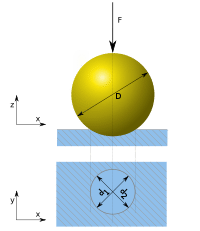Hardness testing is a widely used method to determine the ability of a material to resist deformation, bending, scratching, abrasion, or cutting. It offers a valuable insight into the strength, flexibility, durability, and capabilities of a wide range of components and materials. They can range from raw materials to finished goods. In manufacturing environment, hardness testing is one of the components in materials testing procedure used for quality control, and acceptance of components.
There are a variety of conventional techniques currently available to test the hardness of a material. They include scratch tests, or testing material surfaces with diamonds. With the advent of global industrialization and digital age, these techniques are no longer feasible as there is a requirement for more efficient and time-saving method. Therefore, more refined techniques and material testing devices are developed. Indentation hardness testing is one of the simplest and reliable techniques for testing material hardness. The hardness is measured by loading an indenter of a specified geometry and properties onto the tested material for a definite duration. Measurement are taken as either the depth of penetration or dimensions of the resulting impression or indentation.
As an example, the Brinell Hardness Tester is a material testing device that uses a very high constant load or force, which typically range between 500 to 3000 kgf. The forces are to be applied on the material surface for a 10 to 30 seconds using a 5 or 10-mm diameter tungsten carbide ball. This test is mainly designed for testing of large parts such as large diameter piping, forgings and engine castings as they have a grain structure that is too coarse for other test techniques.
Brinell Hardness Test Method
The test begins with applying a predetermined test load (P) to a carbide ball of fixed diameter (D) and holding it for a predetermined period of time. After removing the load, the depth or the area of the indentation is measured with a specially designed Brinell Microscope or an optical system across at least two diameters. The measurements are usually taken at right angles to each other and the obtained results are averaged to determine the Brinell hardness. The results are then used to generate the Brinell number, which is a function of test force divided by the curved surface area of the indent. The Brinell hardness number is calculated with the help of the following equation. This Brinell number can be further converted into ultimate tensile strength of the material.
In the above equation,
BHN = Brinell hardness number. The number increases with the harder materials.
P = Applied load
D = Diameter of the indenter
d= Diameter of indentation
It should be noted that measurement errors are likely to occur even when measurement are taken in perfect conditions. This can be due to disparities in operators making the measurement or human errors. A computer based Automatic Optical Brinell scopes are developed to remediate these issues. These optical scopes analyze indentation in a consistent manner using imaging software and analysis program with high-resolution video scanning. The size of the indent is determined by measuring two diagonals of the round indent.
Benefits of using Brinell Hardness Test
The Brinell Hardness Test offers many advantages over other hardness test methods. This test is very prominently used in engineering and metallurgy fields as nearly all metals can be tested using this method. While other tests rely only on a set load to test a metal, irrespective of it being fragile or hard, Brinell Hardness Test allows operators to select the appropriate test load and size of ball, depending on the type of metal to be tested. A Brinell Hardness Test is usually non-destructive in nature as the test uses a sphere to evenly distribute pressure along the material surface. This makes it easier to measure the hardness of relatively large test surfaces. In fact, the Brinell testing system is more indicative of the bulk material hardness as compared to other methods which test over a much smaller area and may in fact be measuring impurities or inclusions.
Another advantage of using Brinell Hardness Test for measuring material hardness is that the calculated values of Brinell Hardness Number with the constant values used for a particular material makes it easier to calculate the tensile strength of that material. Since the indentation is observed with a microscope, the results are very accurate and reliable.



